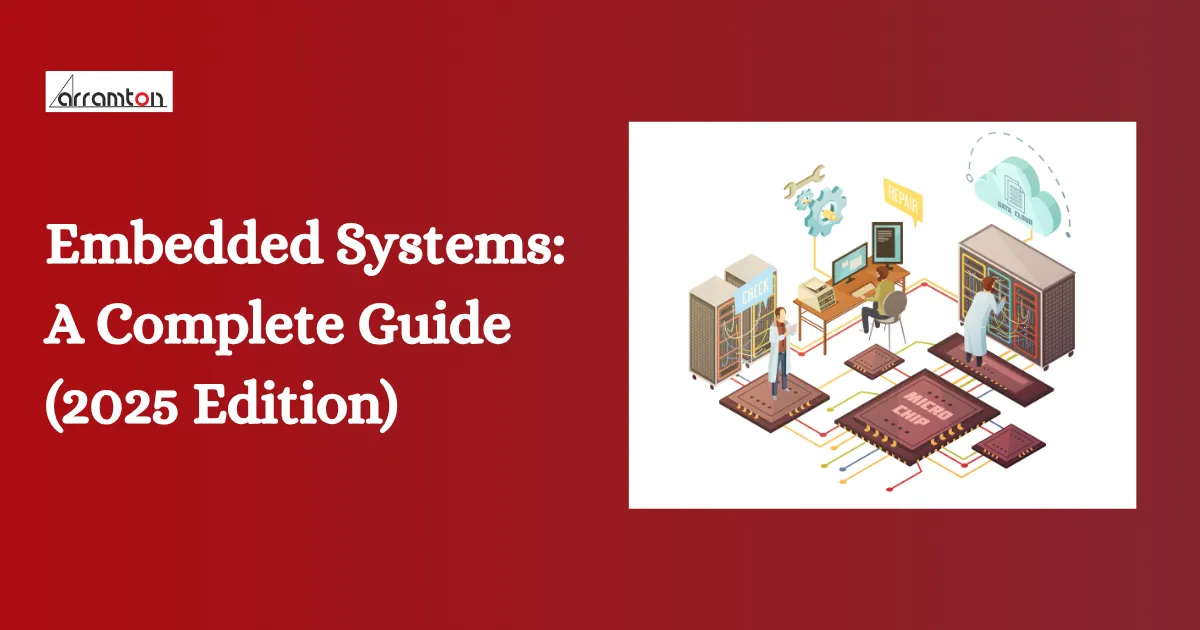Embedded Systems: A Complete Guide (2025 Edition)
Discover the 2025 edition of our comprehensive guide to embedded systems. Understand how they function, explore their core components, real-world use cases, and the latest trends shaping various industries.
Aarushi Kushwaha, 2025-07-28

Embedded systems are the hidden drivers of modern technology, easily powering everything from smartphones and smartwatches to industrial robots and medical devices.
As we step into 2025, their role has grown more significant with the rise of automation, IoT, and intelligent edge computing.
Whether you're a student, tech enthusiast, or a professional exploring system-level programming, this complete guide will help you understand what embedded systems are, how they work, their real-world applications, and where the technology is headed.
Table of Contents
- What Are Embedded Systems?
- Key Components of Embedded Systems
- Types of Embedded Systems
- How Embedded Systems Work
- Embedded Hardware and Software: Working in Harmony
- Memory Management in Embedded Systems
- Advantages and Limitations of Embedded Systems
- Latest Trends in Embedded Systems (2025)
- Tools and Technologies Used in Embedded System Development
- Skills Required for Embedded Systems Engineers
- 1. Proficiency in Programming Languages (C/C++ & Assembly)
- 2. Knowledge of Microcontrollers and Microprocessors
- 3. Familiarity with Real-Time Operating Systems (RTOS)
- 4. Circuit Design and PCB Fundamentals
- 5. Debugging and Testing Skills
- 6. Embedded Communication Protocols
- 7. Low-Power Design and Optimization
- 8. Problem-Solving and Analytical Thinking
- Future of Embedded Systems
- Conclusion
- Frequently Asked Questions
- Q. What is an embedded system in simple terms?
- Q. Which industries use embedded systems the most?
- Q. Is embedded systems a good career in 2025?
- Q. What programming languages are used in embedded systems?
- Q. What are the best IDEs for embedded development in 2025?
- Q. Why is memory management important in embedded systems?
What Are Embedded Systems?
An embedded system is a specialized computing system that performs dedicated functions within a larger mechanical or electrical system. Unlike general-purpose computers, embedded systems are designed to carry out specific tasks efficiently, often in real-time.
These systems combine hardware and software components and are typically built around microcontrollers or microprocessors.
You can find embedded systems in countless devices around you, from washing machines, smart thermostats, and medical devices to advanced automotive control systems and industrial machines.
They are integral to the smooth operation of smart technologies, providing automation, precision, and control across various sectors.
In 2025, embedded systems continue to evolve rapidly, integrating with technologies like AI, IoT, and edge computing, making them smarter, faster, and more energy-efficient than ever before.
Key Components of Embedded Systems
An embedded system is a combination of both hardware and software, designed to perform a dedicated function within a larger system. Understanding its core components is essential to grasp how these systems operate efficiently and reliably.
Below are the key building blocks that make up an embedded system:
1. Microcontroller or Microprocessor
At the heart of every embedded system lies a microcontroller or microprocessor. This acts as the brain of the system, executing instructions, processing data, and controlling other components. Microcontrollers are preferred for most embedded systems due to their built-in memory and peripherals.
2. Memory (RAM and ROM)
Memory is crucial for data storage and processing. RAM (Random Access Memory) handles temporary data while the system is running, and ROM (Read-Only Memory) stores the firmware or software instructions that don’t change during operation.
3. Input Devices
Sensors, switches, or buttons serve as input devices. They allow the embedded system to receive signals from the external environment, such as temperature, motion, or pressure.
4. Output Devices
These are used to communicate the result of processing. Output components could be displays (LEDs, LCDs), motors, speakers, or even wireless transmitters depending on the system’s application.
5. Communication Interfaces
Embedded systems often need to exchange data with other devices or systems. Interfaces like UART, SPI, I2C, CAN, or even wireless protocols such as Bluetooth or Wi-Fi are commonly used for this purpose.
6. Power Supply
A stable and sufficient power supply ensures reliable operation of all components. Many embedded systems are designed for low power consumption, especially in battery-operated or portable devices.
7. Embedded Software (Firmware)
The software embedded in the device’s ROM controls how the hardware operates. This firmware is written in languages like C or C++ and is often optimized for speed, size, and energy efficiency.
Types of Embedded Systems
Embedded systems can be categorized based on performance, functionality, and application scope. Each type is designed to serve specific operational needs, ranging from simple household devices to complex industrial machines. Understanding the different types helps in choosing the right system architecture for any given task.
1. Real-Time Embedded Systems
These systems are designed to respond to inputs or events within a strict time constraint. They are commonly used in safety-critical applications such as airbags, medical devices, and industrial automation.
2. Standalone Embedded Systems
A standalone embedded system works independently without needing a host system like a computer. Devices like washing machines, microwave ovens, and digital cameras are examples where the system performs a dedicated function on its own.
3. Networked Embedded Systems
These systems are connected to a network (like LAN, WAN, or the internet) and communicate with other devices or servers. Examples include smart home devices, ATM machines, and networked security systems. They often form the backbone of IoT ecosystems.
4. Mobile Embedded Systems
Mobile embedded systems are found in portable devices like smartphones, tablets, fitness trackers, and GPS navigation units. These systems emphasize power efficiency, compact size, and wireless connectivity.
5. Small-, Medium-, and Large-Scale Embedded Systems
This classification is based on system complexity and performance needs:
- Small-scale: Built using 8-bit or 16-bit microcontrollers; used in devices like electric kettles or TV remotes.
- Medium-scale: More complex, using 16-bit or 32-bit controllers; found in smart thermostats, vending machines, or smart TVs.
- Large-scale: Highly complex systems with multiple processors; used in aerospace, automotive control systems, and industrial machinery.
How Embedded Systems Work
Embedded systems function as dedicated computing units designed to perform specific tasks within larger systems. At their core, they combine hardware components, like microcontrollers or microprocessors, with embedded software programmed to control inputs and outputs in real time.
The system receives input data from connected sensors or user interfaces, processes this data using its internal logic, and then sends signals to output devices such as motors, displays, or other components.
Unlike general-purpose computers, embedded systems operate within strict constraints related to power, memory, and processing capacity. They are optimized for efficiency, reliability, and speed, often running on real-time operating systems (RTOS) to ensure timely task execution.
From traffic lights and washing machines to industrial robots and medical devices, the effortless interaction between hardware and software in embedded systems is what allows them to perform consistently and autonomously within their intended environment.
Embedded Hardware and Software: Working in Harmony
Embedded systems are fundamentally built on two tightly coupled pillars, embedded hardware and software. The hardware includes components like microcontrollers, sensors, actuators, and communication interfaces. Meanwhile, the embedded software (firmware) defines how the hardware behaves and responds to different conditions.
Together, these elements form a system that’s optimized for performance, energy efficiency, and real-time execution. A well-designed balance between embedded hardware and software is crucial to ensure stability, fast response, and reliable task execution in applications such as wearable tech, automotive control units, and industrial automation tools.
Memory Management in Embedded Systems
Memory management in embedded systems is a critical aspect of design, especially due to their limited RAM and ROM. Efficient memory allocation ensures optimal performance, prevents crashes, and reduces power consumption, particularly important in battery-powered and time-sensitive environments.
Embedded developers must manually manage memory by allocating static memory when possible, minimizing dynamic allocation, and avoiding memory leaks.
This level of precision allows embedded systems to run predictably, even under constrained hardware conditions. Tools like stack analyzers and memory profilers are often used to help monitor usage throughout development.
Advantages and Limitations of Embedded Systems
Embedded systems offer a range of benefits that make them indispensable in modern technology. Their compact size, low power consumption, and specialized functionality enable easy integration into devices like smart appliances, automotive control units, medical equipment, and industrial automation tools.
They are optimized for specific tasks, ensuring high reliability, fast performance, and real-time responsiveness, qualities critical for systems where precision and timing are paramount.
However, embedded systems also come with certain limitations. Since they are designed for dedicated functions, they typically lack flexibility and cannot be easily reprogrammed or upgraded.
The development process can be complex and time-consuming, especially when working with hardware-software integration. Additionally, once deployed, diagnosing or fixing issues often requires expert knowledge and may involve physical access to the device.
Understanding both the strengths and constraints of embedded systems helps in making informed decisions when designing or implementing technology solutions in 2025 and beyond.
Latest Trends in Embedded Systems (2025)
The embedded systems landscape in 2025 is rapidly evolving, driven by the demand for smarter, faster, and more efficient devices. Emerging technologies are shaping how embedded systems are designed, deployed, and scaled across industries.
Here are some of the most significant trends transforming the field this year:
1. AI-Powered Embedded Systems
Artificial Intelligence and Machine Learning are being increasingly integrated into embedded devices, enabling them to make intelligent decisions at the edge. From facial recognition in security cameras to predictive maintenance in industrial equipment, AI-enhanced embedded systems are revolutionizing real-time data processing.
2. Edge Computing for Faster Response
Edge computing is gaining prominence, especially in applications requiring low-latency processing like autonomous vehicles and industrial automation. By processing data closer to the source, embedded systems are reducing dependency on cloud infrastructure and improving response times.
3. Increased Focus on Cybersecurity
As embedded devices connect to broader networks (especially in IoT), the need for robust security has never been greater. Secure boot, data encryption, and real-time threat detection are becoming standard features in embedded system design to safeguard sensitive data.
4. Integration with IoT Ecosystems
Embedded systems continue to serve as the backbone of IoT ecosystems. In 2025, there's a notable push toward interoperability, where devices can easily communicate across platforms using standardized protocols like MQTT, CoAP, and Thread.
5. Energy-Efficient Designs
With rising demand for battery-powered and portable devices, energy efficiency is a key focus. Low-power microcontrollers, dynamic power scaling, and energy harvesting technologies are helping embedded systems operate longer with minimal energy consumption.
6. Use of Real-Time Operating Systems (RTOS)
The use of RTOS is expanding, especially in mission-critical applications. Developers are opting for lightweight and modular RTOS platforms that offer deterministic performance, better task management, and enhanced debugging tools.
Tools and Technologies Used in Embedded System Development
Developing embedded systems requires a mix of hardware tools, software environments, and debugging platforms customized to meet specific design goals.
These tools enable developers to write, test, and deploy code efficiently on embedded devices while optimizing for speed, memory usage, and power consumption.
Below are the essential tools and technologies commonly used in embedded system development in 2025:
1. Programming Languages for Embedded Systems
C and C++ continue to dominate embedded programming due to their low-level hardware control and memory efficiency.
Python is also gaining traction for prototyping, while Rust is emerging for safety-critical applications thanks to its strong memory safety guarantees.
2. Integrated Development Environments (IDEs)
Popular IDEs like Keil µVision, MPLAB X, IAR Embedded Workbench, and Eclipse with CDT offer comprehensive environments for coding, compiling, and debugging embedded applications.
These tools support various microcontroller families and allow integration with external debuggers and simulators.
3. Real-Time Operating Systems (RTOS)
RTOS platforms like FreeRTOS, RTEMS, Zephyr, and VxWorks are essential for time-sensitive applications. They provide scheduling, task management, and resource allocation to ensure predictable behavior in real-time environments.
4. Simulation and Debugging Tools
Hardware simulators such as Proteus, QEMU, and TINA allow developers to simulate circuit behavior and test firmware without physical hardware. For real-device debugging, tools like JTAG, ST-LINK, and Segger J-Link are widely used to monitor and debug program execution.
5. Embedded Hardware Platforms
Development boards such as Arduino, Raspberry Pi, ESP32, and STM32 Nucleo are frequently used for prototyping and commercial development.
These boards come with extensive community support and libraries, speeding up development cycles.
6. Communication Protocol Analyzers
For systems that rely on interfaces such as I2C, SPI, UART, or CAN, tools like logic analysers and protocol analysers aid in testing and troubleshooting data transmissions, ensuring smooth communication between system components.
Skills Required for Embedded Systems Engineers
To thrive as an embedded systems engineer in 2025, professionals must master a unique combination of hardware understanding and software expertise. The role demands precision, problem-solving ability, and the capacity to build efficient, reliable systems customized for specific tasks.
Below are the essential skills every embedded systems engineer should have.
1. Proficiency in Programming Languages (C/C++ & Assembly)
C and C++ remain the backbone of embedded software development due to their direct hardware access and efficiency. Assembly language may also be needed for low-level hardware interactions and optimization in resource-constrained systems.
2. Knowledge of Microcontrollers and Microprocessors
Understanding the architecture, functionality, and programming of microcontrollers (like ARM Cortex, STM32, AVR) and microprocessors is crucial for selecting the right hardware for an application.
3. Familiarity with Real-Time Operating Systems (RTOS)
RTOS such as FreeRTOS, VxWorks, or Zephyr help manage multitasking in embedded environments. Engineers must know how to implement task scheduling, semaphores, interrupts, and memory management.
4. Circuit Design and PCB Fundamentals
Hands-on knowledge of electronics, circuit schematics, and PCB design tools like Altium or KiCad helps engineers prototype, debug, and integrate hardware effectively.
5. Debugging and Testing Skills
Engineers must be proficient with debugging tools such as JTAG, oscilloscopes, logic analyzers, and simulation environments. Effective testing ensures reliability and helps identify timing or memory issues early.
6. Embedded Communication Protocols
Understanding standard protocols like I2C, SPI, UART, CAN, and USB is vital to interface embedded systems with sensors, peripherals, or other devices.
7. Low-Power Design and Optimization
With the rise of IoT and wearable devices, engineers should be able to optimize power consumption through sleep modes, energy-efficient coding, and hardware selection.
8. Problem-Solving and Analytical Thinking
Developing embedded systems often involves dealing with complex timing, resource constraints, and system bugs. Strong analytical and troubleshooting skills are essential to navigate these challenges.
Future of Embedded Systems
The future of embedded systems looks exceptionally promising as they continue to drive innovation across industries. With rapid advancements in embedded AI tools, IoT, and edge computing, embedded systems are evolving from isolated units into intelligent, interconnected solutions that enable smarter environments.
In 2025 and beyond, their role will be more critical than ever in shaping automation, mobility, and digital experiences.
1. AI-Powered Embedded Intelligence
Artificial Intelligence is being increasingly integrated into embedded systems, allowing devices to process data locally, make decisions in real time, and reduce dependence on cloud computing. This shift is enabling smarter wearables, autonomous vehicles, and intelligent industrial automation.
2. Growth of Edge Computing
Edge computing is revolutionizing how embedded systems function by bringing processing closer to the data source. In 2025, edge-enabled embedded systems are expected to dominate use cases in remote monitoring, real-time analytics, and latency-sensitive applications like robotics and smart factories.
3. Security-First Architecture
As embedded systems become more connected, cybersecurity is becoming a top priority. The future will see widespread adoption of secure boot, hardware-level encryption, and real-time anomaly detection to safeguard against cyber threats.
4. Energy-Efficient and Sustainable Designs
With growing environmental concerns and the need for battery-powered devices, energy-efficient embedded systems are gaining momentum. Expect a surge in ultra-low-power processors and components optimized for green computing in embedded design.
5. Expanding Role in IoT Ecosystems
Embedded systems are the backbone of the Internet of Things. In the coming years, they will play a pivotal role in expanding smart infrastructure, from connected homes to smart cities, enabling effective communication between millions of devices.
Conclusion
As embedded systems continue to evolve, their impact on industries and everyday life is becoming more profound. In 2025, they're not just embedded, they're intelligent, connected, and indispensable.
From enabling smart homes to driving autonomous vehicles and automating factories, embedded systems are shaping the future of technology.
By understanding their components, applications, and future trends, individuals and organizations can better prepare for the next wave of innovation.
Furthermore, connect with Arramton Infotech if you require services, such as software development, iOS & Android app development, web designing services, or more.
Frequently Asked Questions
Q. What is an embedded system in simple terms?
Ans: An embedded system is a specialized computing system that performs dedicated functions within a larger device. Unlike general-purpose computers, it's designed for specific tasks, such as controlling a washing machine, a GPS device, or a pacemaker.
Q. Which industries use embedded systems the most?
Ans: Embedded systems are widely used in automotive, healthcare, telecommunications, consumer electronics, aerospace, and industrial automation. Their compact size, reliability, and task-specific design make them ideal for a variety of applications.
Q. Is embedded systems a good career in 2025?
Ans: Yes, embedded systems engineering is a promising career in 2025. With increasing demand for IoT, smart devices, and real-time computing, professionals skilled in embedded software and hardware development are highly sought after.
Q. What programming languages are used in embedded systems?
Ans: C and C++ are the most commonly used languages in embedded system development tools. Other languages like Python, Assembly, and Rust are also gaining traction, depending on the complexity and performance requirements of the system.
Q. What are the best IDEs for embedded development in 2025?
Ans: Some of the best IDEs for embedded development include Keil µVision, MPLAB X IDE, IAR Embedded Workbench, STM32CubeIDE, and Eclipse CDT. These IDEs offer advanced debugging features, hardware integration, and support for a wide range of microcontrollers.
Q. Why is memory management important in embedded systems?
Ans: Memory management in embedded systems ensures efficient use of limited RAM and ROM. It helps maintain system stability, reduce energy consumption, and prevent issues like memory leaks or overflows—especially important in real-time or safety-critical applications.
Empowering Businesses with Technology
Recent Blogs

Best Performance Marketing Agencies in the UK
Discover the leading performance marketing agencies in the UK for 2025. Find expert firms focused on ROI-driven strategies, including PPC, SEO, and data-driven digital campaigns.
Deepali Dahiya Aug 7, 2025

Top 12 Benefits of Working with a Custom Web Development Agency
Explore the top 12 benefits of partnering with a custom web development agency in 2025. See how personalized solutions, skilled professionals, and scalable designs can elevate your brand and accelerate digital growth.
Aarushi Kushwaha Aug 5, 2025

Best Accounting Software for Property Management 2025
Explore the top accounting software for property management in 2025. Ideal for landlords, investors, and property managers looking to simplify financial tracking and improve operational efficiency.
Deepali Dahiya Aug 4, 2025

Why You Should Invest in Custom E-commerce Websites
Explore the top reasons to invest in a custom e-commerce website in 2025. Uncover how personalized design, superior functionality, and scalable solutions can boost conversions and give your brand a competitive edge.
Aarushi Kushwaha Jul 31, 2025